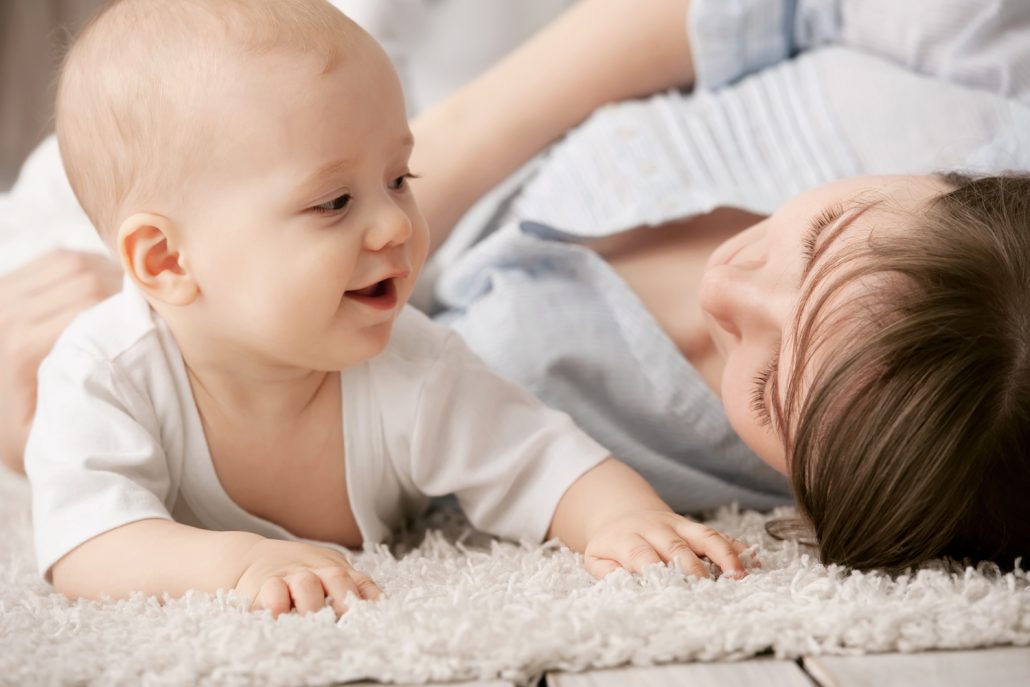Baby cues & understanding body language
A baby learns to talk in the first two years of life, and in this timeframe a wide variety of developmental milestones are passed that contribute to the skills needed to communicate.
Being understood before these first words, can be frustrating for parent and child, as both attempt to understand and be understood. Thankfully with some keen observation there is plenty to fill this communication gap. Knowing the cues and body language of a baby, before they reach these milestones, can make being understood that much easier, for everyone.
Tuning into baby signals
The origin of the word ‘baby’ most probably comes from an infant’s first attempt at speech. In contrast to this ‘infant’ is derived from latin, translating literally as ‘unable to speak’. This would assume that ‘speak’ means the use of proper words, as babies are far from silent. From the ‘goos’ and ‘gaas’ post napping, to the ‘help me right now’ screaming, there is plenty of communication, that does not require proper speech to be understood.
After all, there is a long time between when we utter our first word, most commonly ‘Mama’ and ‘Dada’ at around six months, and even longer before we work up to small sentences of a few words, somewhere between eighteen months and two years of age. As such, the need for body language is essential for communication, as is the awareness required to recognise it.
Cries, coo’s and everything in-between
The most predominant form of verbal communication with a newborn is crying, and this remains an effective tool throughout childhood. Just as in the study of linguistics, the tone, pitch and accent of a cry can have a variety of meanings. In its simplest form of course, a cry is for attention, but attention to what exactly, varies greatly?
Baby cries will fall into their basic needs of food, sleep and comfort. So a cry that is for hunger will be different for tiredness. A loss of comfort may be due to many sources, for example pain from a gassy stomach or an unchanged nappy that is starting a rash. Discomfort may also come from fear, such as a loud noise, or it could be the need for some company or even the opposite, to be less stimulated and have some quiet time alone.
Taking a mental note of each cry and what it turns out to represent, could pay off, as the need that stared the cry is sure to repeat itself.
The hardest part of crying is that it evokes a range of feelings and is distressing for everyone involved. So keeping calm is easier said than done, but the reward for doing so is that that it provides space to think laterally. This time can then be spent productively asking ‘What do I think my baby is telling me?’ and looking carefully at the baby’s physical communication as a whole.
Also baby’s will mirror emotion, so calmness may slow the escalation of crying, and eye contact will give acknowledgement, and hope that they might be understood.
Other more subtle sounds such as cooing and gurgling are built upon over time, with ‘ooh’ and ‘agh’ vowel sounds introduced later, so that there is a whole monologue to enjoy. Once again the tone, pitch and accents of these sounds can be used to better translate. A baby’s inspiration for talking is drawn upon the mirroring of a parents sounds. This also provides an opportunity to connect, talking back and helping to build a baby’s repertoire of sounds.
Whether it is subtle grunts or coos, laughter or crying, sound alone offers only so much information, but combined with the language of the body, a baby’s movements can offer a much better picture of what is needed.
The art of interpreting baby body language
Eye contact can be a great indicator as to what a baby needs, which may simply be that they require more attention. Conversely, if a baby avoids eye contact it can mean they are over stimulated. If they have trouble focusing, it could mean its time for a nap.
As you are looking at the baby, so it is looking at you, picking up on your facial expressions and once again imitating. So being mindful of how you look, move and even how you sound, will influence the reactions of an infant. Subtle or not, a parents sounds and expressions all make up for the non verbal communication that babies rely on for feedback. In turn, a baby’s smiling can convey physical contentment or a frown, dissatisfaction.
Further to facial expression, the rest of the body can offer information. Those little fists could indicate hunger, that then relax and open once the tummy is full. The rubbing of the face against something in the early months, or later on the pulling on ears or rubbing of eyes, is an early sign of tiredness. An arched back could signal they have finished eating or combined with crying it could point to reflux. Raising the knees and fidgeting may mean a gassy stomach.
Some signs are more obvious, such as gnawing or sucking of either your hand or theirs, can mean hunger. Pointing for something they need, kicking of legs in excitement or jerking of the legs or arms when startled, are all well known signals. Sometimes it is what they don’t do. For example becoming quiet, still and no longer interacting with people or toys, is an indication that it is time for a nap.
Catching these signals earlier rather than later, helps address the baby’s needs before distress sets in. Of course this is all theory and every baby is different, yet some small changes to how we approach our interaction with a baby, can better the chances of successfully understanding their present and future needs.
Making room for being in the moment
Picking up on baby cues and body language can be difficult if dealing with the daily tasks involved with raising a child, especially a baby that is entirely dependent upon the parent. Ideally both baby and parent have the space in which to communicate, to not be distracted by other stresses such as work, or the pressure to have the rest of the daily tasks in order. Ask any parent and they will tell you that organised chaos is part of having kids.
Allowing one self to be in the moment will help observe the subtly of what the baby is doing, aiding the ability to communicate. Being in the ‘here and now’ can be relaxing in itself, quietly interacting and waiting patiently to see what happens next.
The provision of time for both baby and parent to have this space, separate to the rush of the day, can grow the sensitivity and responsiveness of a parent. It also allows for the focus to be on the child, to help them through the struggles and praise the achievements that each developmental stage brings.
Planning ahead for what comes next
The verbal and physical phases of a baby are constantly changing, so it good to research what stages of development are next. For example, early on a baby squirming can indicate discomfort, yet later at around four or five months, may just be the start of attempting to roll over. There are plenty of online resources available that describe the developmental stages of childhood but sometimes it can be good to discuss them in more detail.
Your doctor can provide information and assistance, up to date resources and specialist health professional referrals as required. If at any point you are concerned about your baby’s development it is best to seek advice immediately. After all you know your baby better than anyone else, and the person who will naturally take the most interest in your child’s welling, will be you.
It is also worth noting that all of the interactions described are essential for brain development, as repetitive and consistent stimulation, develops and strengthens electrical connections within the brain. As the first few years of a baby’s life is an intense period of brain growth, these interactions build a solid foundation for future learning.
A baby’s expression through sound and movement can be met by a parent with interaction, through touch and talking, to develop not only their physical and mental growth, but essential social skills and co-ordination.
This time spent together, good or bad, is never wasted, as it builds understanding of each other, encouraging a stronger emotional bond and relationship, for both parent and baby alike.



